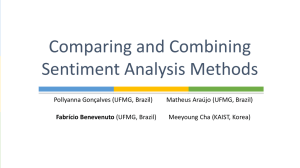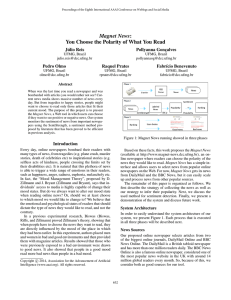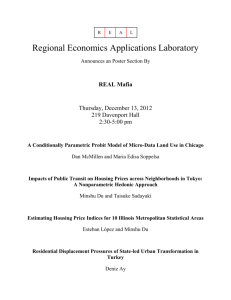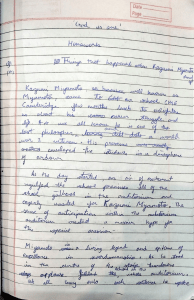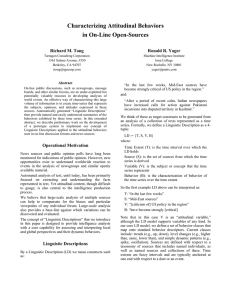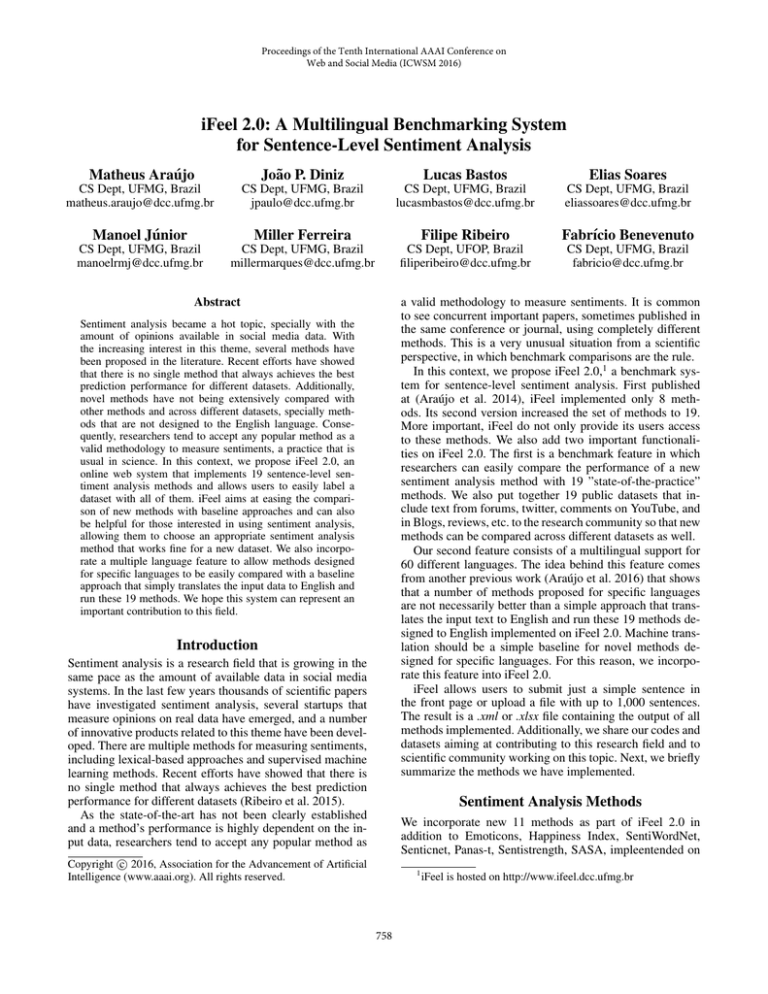
Proceedings of the Tenth International AAAI Conference on
Web and Social Media (ICWSM 2016)
iFeel 2.0: A Multilingual Benchmarking System
for Sentence-Level Sentiment Analysis
Matheus Araújo
João P. Diniz
Lucas Bastos
Elias Soares
CS Dept, UFMG, Brazil
matheus.araujo@dcc.ufmg.br
CS Dept, UFMG, Brazil
jpaulo@dcc.ufmg.br
CS Dept, UFMG, Brazil
lucasmbastos@dcc.ufmg.br
CS Dept, UFMG, Brazil
eliassoares@dcc.ufmg.br
Manoel Júnior
Miller Ferreira
Filipe Ribeiro
Fabrı́cio Benevenuto
CS Dept, UFMG, Brazil
manoelrmj@dcc.ufmg.br
CS Dept, UFMG, Brazil
millermarques@dcc.ufmg.br
CS Dept, UFOP, Brazil
filiperibeiro@dcc.ufmg.br
CS Dept, UFMG, Brazil
fabricio@dcc.ufmg.br
a valid methodology to measure sentiments. It is common
to see concurrent important papers, sometimes published in
the same conference or journal, using completely different
methods. This is a very unusual situation from a scientific
perspective, in which benchmark comparisons are the rule.
In this context, we propose iFeel 2.0,1 a benchmark system for sentence-level sentiment analysis. First published
at (Araújo et al. 2014), iFeel implemented only 8 methods. Its second version increased the set of methods to 19.
More important, iFeel do not only provide its users access
to these methods. We also add two important functionalities on iFeel 2.0. The first is a benchmark feature in which
researchers can easily compare the performance of a new
sentiment analysis method with 19 ”state-of-the-practice”
methods. We also put together 19 public datasets that include text from forums, twitter, comments on YouTube, and
in Blogs, reviews, etc. to the research community so that new
methods can be compared across different datasets as well.
Our second feature consists of a multilingual support for
60 different languages. The idea behind this feature comes
from another previous work (Araújo et al. 2016) that shows
that a number of methods proposed for specific languages
are not necessarily better than a simple approach that translates the input text to English and run these 19 methods designed to English implemented on iFeel 2.0. Machine translation should be a simple baseline for novel methods designed for specific languages. For this reason, we incorporate this feature into iFeel 2.0.
iFeel allows users to submit just a simple sentence in
the front page or upload a file with up to 1,000 sentences.
The result is a .xml or .xlsx file containing the output of all
methods implemented. Additionally, we share our codes and
datasets aiming at contributing to this research field and to
scientific community working on this topic. Next, we briefly
summarize the methods we have implemented.
Abstract
Sentiment analysis became a hot topic, specially with the
amount of opinions available in social media data. With
the increasing interest in this theme, several methods have
been proposed in the literature. Recent efforts have showed
that there is no single method that always achieves the best
prediction performance for different datasets. Additionally,
novel methods have not being extensively compared with
other methods and across different datasets, specially methods that are not designed to the English language. Consequently, researchers tend to accept any popular method as a
valid methodology to measure sentiments, a practice that is
usual in science. In this context, we propose iFeel 2.0, an
online web system that implements 19 sentence-level sentiment analysis methods and allows users to easily label a
dataset with all of them. iFeel aims at easing the comparison of new methods with baseline approaches and can also
be helpful for those interested in using sentiment analysis,
allowing them to choose an appropriate sentiment analysis
method that works fine for a new dataset. We also incorporate a multiple language feature to allow methods designed
for specific languages to be easily compared with a baseline
approach that simply translates the input data to English and
run these 19 methods. We hope this system can represent an
important contribution to this field.
Introduction
Sentiment analysis is a research field that is growing in the
same pace as the amount of available data in social media
systems. In the last few years thousands of scientific papers
have investigated sentiment analysis, several startups that
measure opinions on real data have emerged, and a number
of innovative products related to this theme have been developed. There are multiple methods for measuring sentiments,
including lexical-based approaches and supervised machine
learning methods. Recent efforts have showed that there is
no single method that always achieves the best prediction
performance for different datasets (Ribeiro et al. 2015).
As the state-of-the-art has not been clearly established
and a method’s performance is highly dependent on the input data, researchers tend to accept any popular method as
Sentiment Analysis Methods
We incorporate new 11 methods as part of iFeel 2.0 in
addition to Emoticons, Happiness Index, SentiWordNet,
Senticnet, Panas-t, Sentistrength, SASA, impleentended on
c 2016, Association for the Advancement of Artificial
Copyright Intelligence (www.aaai.org). All rights reserved.
1
758
iFeel is hosted on http://www.ifeel.dcc.ufmg.br
timent analysis methods. We also hope our system can represent an important contribution for researchers interested
in using sentiment analysis as it allows users to investigate
which method would perform better in novel datasets.
Acknowledgments
This work was partially supported by the project FAPEMIGPRONEX-MASWeb, Models, Algorithms and Systems for
the Web, process number APQ-01400-14, and by individual
grants from CNPq, CAPES, and Fapemig.
Figure 1: iFeel Architeture
References
iFeel 1.0: These methods are Opinion Lexicon (Hu and
Liu 2004), Opinion Finder (Wilson, Wiebe, and Hoffmann
2005), AFINN (Nielsen 2011), SO-CAL (Taboada et al. ),
Emoticons Distant Supervision(Hannak et al. 2012), NRC
Hashtag (Mohammad 2012), EmoLex (Mohammad and
Turney 2013), SANN (Pappas and Popescu-Belis 2013),
Sentiment140 Lexicon (Mohammad, Kiritchenko, and Zhu
2013), Stanford Recursive Deep Model (Socher et al. 2013),
Umigon (Levallois 2013), Vader (Hutto and Gilbert 2014).
All those methods are deeply discussed in (Ribeiro et al.
2015).
Araújo, M.; Gonçalves, P.; Benevenuto, F.; and Cha, M. 2014.
ifeel: A system that compares and combines sentiment analysis
methods. In Proc. of WWW.
Araújo, M.; Reis, J. C.; Pereira, A. C.; and Benevenuto, F.
2016. An evaluation of machine translation for multilingual
sentence-level sentiment analysis. In Proc. of ACM SAC.
Hannak, A.; Anderson, E.; Barrett, L. F.; Lehmann, S.; Mislove, A.; and Riedewald, M. 2012. Tweetin’ in the rain: Exploring societal-scale effects of weather on mood. In Proc. of
ICWSM.
Hu, M., and Liu, B. 2004. Mining and summarizing customer
reviews. In Proc. of KDD.
Hutto, C., and Gilbert, E. 2014. Vader: A parsimonious rulebased model for sentiment analysis of social media text. In
Proc. of ICWSM.
Levallois, C. 2013. Umigon: sentiment analysis for tweets
based on terms lists and heuristics. In Proc. of SemEval.
Mohammad, S., and Turney, P. D. 2013. Crowdsourcing a
word-emotion association lexicon. Computational Intelligence
29(3).
Mohammad, S. M.; Kiritchenko, S.; and Zhu, X. 2013. Nrccanada: Building the state-of-the-art in sentiment analysis of
tweets. In Proc. of SemEval.
Mohammad, S. 2012. #emotional tweets. In Proc. of SemEval.
Nielsen, F. Å. 2011. A new anew: Evaluation of a word
list for sentiment analysis in microblogs. arXiv preprint
arXiv:1103.2903.
Pappas, N., and Popescu-Belis, A. 2013. Sentiment analysis
of user comments for one-class collaborative filtering over ted
talks. In Proc. of SIGIR.
Ribeiro, F.; Araújo, M.; Gonçalves, P.; Benevenuto, F.; and
Gonçalves, M. 2015. A benchmark comparison of stateof-the-practice sentiment analysis methods. arXiv preprint
arXiv:1512.01818.
Socher, R.; Perelygin, A.; Wu, J. Y.; Chuang, J.; Manning,
C. D.; Ng, A. Y.; and Potts, C. 2013. Recursive deep models for semantic compositionality over a sentiment treebank.
In Proc. of EMNLP.
Taboada, M.; Brooke, J.; Tofiloski, M.; Voll, K.; and Stede,
M. Lexicon-based methods for sentiment analysis. Comput.
Linguist.
Wilson, T.; Wiebe, J.; and Hoffmann, P. 2005. Recognizing
contextual polarity in phrase-level sentiment analysis. In Proc.
ACL.
iFeel Architeture
The iFeel 2.0 Web application has changed from the original
iFeel 1.0 as well. Now it uses Meteor 2 , a full stack web
framework that uses NodeJS as server-side javascript engine
and MongoDB to persist data. The superficial architecture
of iFeel 2.0 is shown on Figure 1. It corresponds to a Web
Application that has support from the translation API and
shares a database to a java client.
The Java client is the sentiment analysis core in our system that puts all 19 methods implemented to run in different
threads. It implements a Distributed Data Protocol (DDP)
to communicate with the Web Application. When a user uploads a sentence or a file, everything is saved on the database
and the java client is alerted to request those sentences. After
analysing, everything is submitted back to the database and
the access to the results is granted to the user.
Multilinguage Support
As discussed before, our approach for multilanguage sentiment consists of a basic baseline for novel efforts on
sentence-level sentiment analysis. It consists of translating
the input text to English and run the 19 methods implemented on iFeel. To translate text we use the Yandex Translation API3 , as it is a free API that converts user input from
60 different languages when requested.
Conclusion
In this work, we proposed iFeel 2.0, a system that implements 19 sentiment analysis methods. The system aims at
allowing new methods, proposed in English or other languages, to be compared with 19 known sentence level sen2
3
https://www.meteor.com/
https://tech.yandex.com/translate/
759

